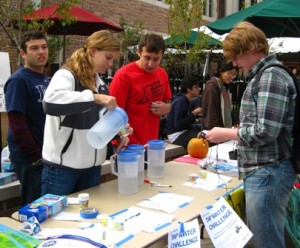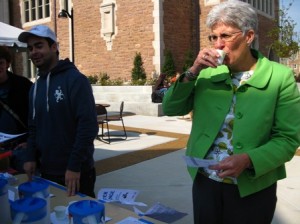We have much more to do and your continued support is needed now more than ever.
Students Say “Tap It” for the Good of the Planet

“This was a measure that the administration wanted to support, if our students wanted to support it,” explains Deborah Howard, special assistant to the executive vice chancellor for administration at WUSTL.
The idea to ban bottled water was brought to the student union during the fall 2008 semester, and a student-led, campus-wide “Tap It” campaign was then launched to support the ban and promote drinking more tap water. (Note: Students are allowed to bring and drink bottled water on campus. They just cannot buy it on campus.)
Part of the “Tap It” campaign included asking students to sign a pledge to not buy bottled water, and, to raise additional awareness, students set up blind taste-tests to determine if people could tell the difference between tap water and bottled water. “No one could tell the difference,” says Howard.
St. Louis is especially fortunate in this regard: the city’s tap water was rated as the “Best Tasting City Water in America” by the U.S. Mayor’s Conference in 2007. Not everyone is so lucky. Some schools in the U.S. have had students test tap water on their campuses only to find excessive levels of lead or other contaminants, which may support the use of bottled water from a safety standpoint.
By the end of the semester the campaign proved successful and students chose to support the bottled water ban. Most of the university’s bottled water was removed by January 1, 2009, except for two campus markets that continued to sell water until March 15th, partly because there was a lot of inventory left and partly “to see if there really was a reduced interest in bottled water,” explains Howard, “and luckily there was. Bottled water sales there plummeted.”
According to the International Bottled Water Association (IBWA), bottled water stood as the second-largest beverage type sold by volume in the United States in 2008, coming in behind carbonated soft drinks (CSD). Americans spend about $11.2 billion on bottled water each year, with each person buying an average of 28.5 gallons. But what are they buying?

Understanding this fascination with bottled water has kept Jarvis busy for the last 20 years of his career. In 2008, Jarvis convened a special panel on bottled water at the annual National Ground Water Association conference. The panel considered how much “water” it takes to make bottled water. Factoring in that 24 gallons of water are needed to make one pound of plastic and that 1.5 to 2.7 million tons of plastic are used each year to make bottles for bottled water, it is estimated that nearly 1.3 gallons of water are “virtually embedded” in one liter of bottled water.
All water aside, 96 percent of bottled water sold in the U.S. comes in PET (polyethylene terephthalate) plastic bottles, which are made from petroleum. The Container Recycling Institute (CRI) states that 18 million barrels of crude oil are used every year in the production of single-use PET water bottles.
“And that’s just the tip of the iceberg,” says Jarvis. “If you start looking at how much oil is used to move the water around after it’s in these bottles, that’s another step of the hydrocarbon footprint, but then we’re not done. What do we do with the bottles after we’re done with them?”
According to CRI, most people toss their water bottles in the trash. Eight out of 10 end up in the landfill, which is a much lower recycling rate than carbonated soft drinks (CSD) bottles. Many reports state that the higher recycling rates for CSD bottles is tied to the eleven U.S. states that offer a 5- or 10-cent refund value for those CSD bottles. Many of these “bottle laws” are said to be outdated, and most exclude non-carbonated bottles from being eligible for refunds.
Back at Washington University, Deborah Howard is still fielding calls from concerned students and parents asking why their bottled water is gone, but overall the school has been pleased with the outcome. Other universities across the country are also calling Howard, asking how WUSTL made it all happen. “In order to be effective,” Howard explains to them, “it can’t be a top-down thing. It has to be students who want this.”




















